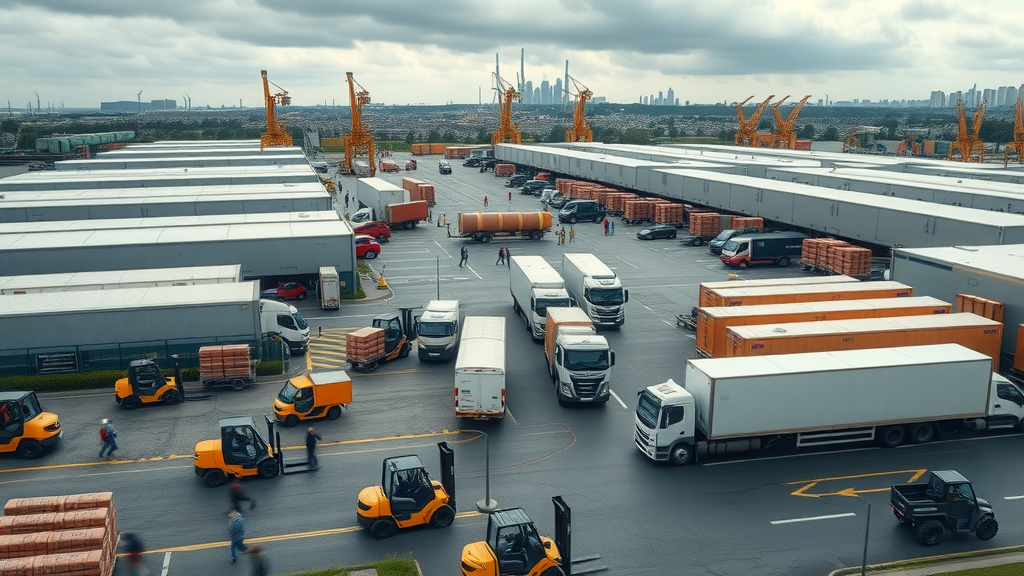Did you know? A single cutting-edge technology implementation can boost construction productivity by more than 30%—redefining what’s possible in the construction industry, for organizations and homeowners alike. Unlock the potential hidden in the latest building construction technology and discover how new innovations are shaping the future of construction projects worldwide. Whether you manage large engineering and construction firms or are an owner looking to future-proof your investment, embracing construction tech is your avenue to efficiency, sustainability, and market leadership. Unlocking Success: How the Latest Building Construction Technology is Revolutionizing the Construction Industry The construction industry stands on the brink of a digital revolution. Across every construction site and within every project, technology has moved from being a luxury to an essential driver of success. The latest building construction technology integrates digital tech, artificial intelligence, and automation, redefining how engineering and construction professionals approach resource management, project management, and the very fabric of the construction process. Organizations investing in these advancements witness not only a measurable boost in efficiency but also elevated safety standards, reduced labor shortages, and unparalleled project delivery speeds. "A recent study reveals that adopting the latest building construction technology can boost productivity by over 30%, redefining the future of the construction industry." For construction companies and their clients—especially those seeking to invest in future-proof assets—the greatest edge comes from leveraging tools like building information modeling (BIM), digital twin platforms, and smart internet-of-things (IoT) systems. These strategies empower construction professionals to avoid costly rework, streamline the construction process, and ensure sustainable practices that align with rapidly changing global standards. Embracing construction tech becomes a strategic imperative, propelling the construction industry toward unprecedented levels of innovation and client satisfaction. What You'll Learn About the Latest Building Construction Technology Fundamental shifts in construction technology impacting building projects
The top construction tech trends transforming engineering and construction
How digital and smart building technology are creating opportunities for efficiency
Expert insights into future-proof construction projects Understanding the Evolution: From Traditional Methods to the Latest Building Construction Technology
Why Construction Technology is Essential to Modern Projects In today’s fast-paced world, construction projects are becoming more complex and demanding. The introduction of the latest building construction technology is transforming every aspect of the engineering and construction sector. No longer can projects rely solely on experience and manual labor; instead, they must adopt resource management platforms, digital tech, and project management tools to remain competitive. These technologies address long-standing issues like labor shortage, inefficiencies, and lack of data transparency, ultimately bringing revolutionary change to construction companies. For both construction professionals and clients, the advantages are profound. Using digital twin technology, modular construction, and integrated information modeling, teams achieve a higher standard of quality and accountability. Construction tech reduces errors, enables predictive maintenance, and fosters real-time collaboration, ensuring that all stakeholders stay informed at every stage of the construction process. As these digital transformation solutions become more accessible, even mid-sized construction firms can offer cutting-edge, energy-efficient, and safe environments for building owners, making technology adoption a critical strategic priority. As the construction sector continues to evolve, many homeowners are also exploring innovative ways to enhance their living spaces using modern building methods. For example, integrating multipurpose garden rooms into your property can be a practical application of these advancements, offering both versatility and value—discover more about this trend in why multipurpose garden rooms are the best addition to your home. Key Milestones in Construction Tech and Digital Transformation The journey from traditional construction techniques to the latest building construction technology is marked by significant milestones. Early mechanized equipment in the engineering and construction sector paved the way for automation and robotics seen on sites today. The development of Building Information Modeling (BIM) set a new standard for collaborative design, enabling 3D visualization and seamless data exchange between architects, engineers, and contractors. More recently, digital twin solutions and machine learning have enabled predictive analytics for risk assessment and resource allocation. As digital transformation continues, the industry witnesses broader integration of new technologies like augmented reality and smart sensors, providing the construction site with actionable, real-time data. These shifts are not merely upgrades—they represent a fundamental reimagining of what construction projects can achieve. Forward-thinking construction firms recognize that every project benefits from enhanced collaboration, faster completion times, and improved resource utilization, all made possible by leveraging the latest building construction technology. The State of the Construction Industry: Embracing the Latest Building Construction Technology
Current Challenges Facing Engineering and Construction The construction industry faces several persistent challenges, from project delays and cost overruns to skilled labor shortages and stringent sustainability expectations. Many traditional construction processes struggle under the weight of regulatory compliance and increasing client demands. Moreover, global competition and resource scarcity have put construction companies under pressure to innovate or risk falling behind. These issues, if unaddressed, can erode profit margins and damage reputations in a market where reliability and delivery speed are critical. However, these challenges also provide the motivation for adopting the latest building construction technology. Solutions like real-time data analytics, digital twin platforms, and automation empower companies to make faster, more informed decisions. By deploying advanced digital tech, organizations not only reduce human error and intervention but also enhance project accountability. The drive to modernize is as much about survival as it is about thriving in a construction industry that rewards those who embrace the future today. Opportunities Driven by Modern Construction Technologies With the rapid rise of innovative digital tools, construction companies are unlocking unprecedented opportunities. Embracing the latest building construction technology enables firms to optimize project management, accelerate construction timelines, and significantly cut operational costs. Technologies such as artificial intelligence and machine learning have started to augment traditional tasks, providing predictive insights and automating repetitive functions. As a result, both engineering and construction teams can redirect human resources toward high-value work while technology handles routine tasks. Moreover, the adoption of advanced construction tech is creating new revenue streams, especially through modular construction and prefabrication. These methods minimize waste, maximize material usage, and turn construction sites into highly efficient, digitally managed workspaces. For project owners and construction professionals alike, the benefits are clear: increased transparency, improved collaboration, and project outcomes that deliver value long after completion. Animated timeline: How construction technology has evolved over the last decade
Top 10 Innovations in the Latest Building Construction Technology Building Information Modeling (BIM)
Modular Construction & Prefabrication
Artificial Intelligence and Machine Learning
Digital Twin and Digital Twins Integration
Augmented Reality and Virtual Reality
Advanced Robotics in Construction Sites
Smart Building Sensors & IoT
3D Printing in Construction Projects
Drones for Construction Site Monitoring
Green Construction Technologies Deep Dive: Building Information Modeling (BIM) as the Backbone of Latest Building Construction Technology
How BIM Transforms Construction Project Management Building Information Modeling (BIM) represents the cornerstone of modern construction tech. Unlike static blueprints, BIM creates a live, digital twin of a building project, centralizing every detail from design and resource allocation to facility management. BIM enhances collaboration, streamlines workflows, and eliminates redundancies in project management. This centralization means that architects, engineers, project managers, and owners collaborate seamlessly—each with access to up-to-date, actionable data for real-time decision-making. With BIM, construction companies embrace information modeling that improves transparency and reduces the chance of expensive errors or rework. Accurate 3D models, combined with predictive analytics, allow teams to spot potential issues early. For project owners and operators, BIM also supports lifecycle asset management—they benefit from the detailed digital record provided as the foundation for maintenance, renovations, and future upgrades, ensuring the latest building construction technology has lasting value. Case Study: BIM Applications in the Construction Industry Consider a major hospital construction project in an urban center. By adopting BIM from the initial concept phase, the project manager and teams leveraged the latest building construction technology to perform virtual walkthroughs, coordinate with contractors in real time, and manage site logistics with digital precision. Potential conflicts between electrical and plumbing systems were resolved in the model phase, before the first wall was built. The results: a faster project timeline, fewer change orders, and higher end-user satisfaction. Such outcomes are now common across construction industries globally. As construction tech matures, BIM applications increasingly include integration with smart sensors, IoT monitoring, and direct links to facility management software. The result is a true digital transformation—one where data flows seamlessly throughout the construction process, improving project outcomes, safety, and sustainability for everyone involved. Modular Construction & Prefabrication: Efficiency Boost with the Latest Construction Technology
Why Modular Methods are a Game-Changer for Construction Sites Modular construction and prefabrication are redefining what’s possible on modern construction sites. By manufacturing components off-site in controlled environments, construction companies minimize weather-related delays, ensure higher quality control, and accelerate delivery schedules. This approach employs digital tech and automation to mass-produce sections of buildings, which are then assembled swiftly onsite, revolutionizing resource management and the construction process. For organizations managing multiple construction projects or clients seeking rapid turnaround, modular construction provides flexibility without sacrificing durability. Prefabrication, backed by information modeling and smart sensors, means reduced waste, improved sustainability, and increased worker safety. While traditional construction sites are susceptible to delays and inefficiency, modular approaches empower construction professionals to deliver on spec, on time, and within budget. Key Benefits for Both Owners and Construction Firms Owners enjoy numerous benefits from modular construction. Buildings go up faster, allowing for earlier occupancy and quicker ROI. Construction firms benefit from predictability, streamlined logistics, and measurable reductions in material waste. The use of the latest building construction technology in modular and prefab also simplifies compliance with environmental regulations and sustainability goals—making these methods highly attractive to both business and residential clients. When combined with BIM and digital twin tools, modular processes enable real-time visualization and tracking, empowering stakeholders to monitor progress, adjust schedules, and mitigate risks proactively. This synergy between modular construction and digital solutions is setting new benchmarks in the construction industry, making it easier for firms to scale innovation across diverse building types. Comparison of Traditional vs. Latest Building Construction Technology Methods Module
Traditional Construction
Latest Construction Technology Cost
Higher costs due to inefficiencies and rework
Lower long-term cost via automation and digital tech Speed
Slower—impacted by weather and manual labor
Faster with prefab, modular, and robotics integration Sustainability
More waste, higher energy consumption
Optimized material use, energy-efficient processes Quality
Variable, subject to human error
Consistent high quality from automation and BIM Technology Integration
Minimal use of digital tools
Full integration with smart tech and real-time data How Digital Twin and Digital Twins Are Shaping Project Management in Modern Construction Tech
Digital Twin Impact on Information Modeling and Operational Visibility Digital twins represent the digital revolution’s leap forward in the construction industry. A digital twin is a real-time, digital replica of a physical asset—created using BIM, IoT sensors, and analytics platforms. This replica offers unmatched operational visibility; construction professionals can simulate, monitor, and manage the entire lifecycle of buildings using accurate, up-to-the-minute data. As a result, digital twin technology improves decision-making, risk management, and asset optimization throughout all phases of the construction process. By extending BIM capabilities, digital twins enable stakeholders—owners, operators, and contractors—to visualize project progress and receive instant feedback from a construction site. When integrated with real-world data, a digital twin streamlines maintenance schedules, detects faults early, and enhances facility management. This continuous loop of information and analytics supports safer, smarter, and more sustainable projects, aligning with the ultimate goals of the latest building construction technology. Big Data and Analytics in Engineering and Construction The power behind digital twins and smart projects is big data. Advanced analytics platforms collect data from IoT-enabled construction sites, wearables, and environmental sensors. This data is analyzed in real time to yield insights for improving safety, reducing waste, forecasting maintenance needs, and optimizing project management strategies. For construction firms, big data unlocks new levels of clarity—enabling faster, evidence-driven decisions that drive project outcomes. As machine learning algorithms and artificial intelligence continue to develop, their intersection with big data in construction technology will only grow. From predictive modeling for project timelines to pattern recognition for quality control, these tools transform engineering and construction teams into proactive, innovation-driven professionals. For forward-thinking construction companies, embracing these analytics-driven practices means staying ahead of the curve and delivering exceptional value. Explainer: What is a Digital Twin in Construction?
Integrating Artificial Intelligence in Latest Building Construction Technology
Applications of AI and Machine Learning in Construction Projects Artificial intelligence (AI) and machine learning are rapidly becoming integral to the engineering and construction landscape. Within the latest building construction technology stack, AI automates scheduling, monitors progress using smart cameras, and even manages on-site resource allocation. Machine learning algorithms digest massive datasets to predict risks, optimize logistics, and simulate outcomes before they impact the construction process. The result: informed decisions and minimized human error at every phase of a construction project. AI-powered platforms elevate project management by providing predictive maintenance schedules, automating invoice verifications, and identifying supply chain disruptions early. Construction firms deploying AI in daily operations not only address traditional labor shortages and safety concerns but also lower operational costs and enhance overall productivity. As a result, construction companies and project owners witness reduced waste, accurate forecasts, and timely project delivery. Reducing Labor Shortage and Enhancing Precision through Smart Automation Labor shortages present significant obstacles to the construction industry, particularly as seasoned professionals retire and fewer younger workers enter the field. The latest building construction technology steps in with automation—robotic arms, autonomous vehicles, and smart machinery—to perform tasks that once required large human teams. These advancements improve site safety and ensure precise, repeatable results, even on highly complex projects where human skill shortages would otherwise cause delays. Smart automation, guided by AI and machine learning, enables “smart” construction sites that dynamically assign tasks, monitor worker safety, and adapt to conditions in real time. By reducing dependency on human input for repetitive or hazardous tasks, construction firms can focus their workforce on higher-value, strategic roles—driving greater job satisfaction and productivity across the industry. Both organizations and property owners benefit from faster project delivery, lower costs, and outstanding quality. Immersive Experiences: Augmented Reality and Virtual Reality in Construction Technology
AR/VR Tools Transforming Construction Sites Virtual reality (VR) and augmented reality (AR) are no longer futuristic concepts—they’re powerful tools actively transforming construction projects. With AR, workers and owners use tablets or smart glasses to overlay building information on the real construction site, instantly accessing measurements, plans, or progress updates. VR allows teams to perform immersive walkthroughs of digital models before construction even begins, identifying clashes and making design decisions collaboratively and early. These immersive technologies, when paired with BIM and digital twin data, enable real-time adjustments that keep projects on track and reduce errors. For construction firms, AR/VR translates into more accurate bidding, improved stakeholder engagement, and a reduction in costly last-minute changes. Clients, meanwhile, enjoy greater visibility of their projects and can offer input before ground is broken—aligning expectations and boosting satisfaction from concept to completion. Safety and Training in Construction Firms with AR/VR Beyond design and project management benefits, AR/VR is revolutionizing workforce safety and training. Construction professionals use VR simulations to rehearse hazardous tasks in completely safe environments—boosting confidence and honing skills before they ever set foot on the actual site. AR headsets provide on-the-job instructions, highlight danger zones, and even monitor compliance with safety protocols in real time. These applications help construction companies address labor shortages by accelerating onboarding and upskilling new employees. Teams learn faster, remember more, and can adapt quickly to new digital tech tools, reducing accidents and downtime. Across the construction industry, firms that embrace AR/VR are cultivating safer worksites and delivering higher-quality outcomes for clients and owners alike. Smart Buildings: IoT, Sensors, and New Smart Building Technology
Creating a Connected Construction Site With Smart Tech The emergence of smart building technology is transforming how construction sites operate and how future buildings will be used. IoT sensors, wireless monitoring devices, and automated controls create a digital nervous system for structures, continuously collecting and transmitting data. On a connected construction site, these smart systems monitor everything from structural integrity to worker movement, equipment usage, temperature, and air quality. By equipping new construction projects with IoT-enabled technology, construction companies boost efficiency, safety, and sustainability. These systems offer real-time alerts on building performance, prevent costly downtime, and streamline energy management for owners. Integrating sensors with BIM and digital twin platforms further extends the digital value chain—giving facility managers a head start on predictive maintenance and lifecycle performance. Case Study: Smart Sensors for Building Monitoring One high-profile example is a new high-rise development in a coastal city. By embedding IoT sensors throughout the structure, the construction firm provided the owner with real-time surveillance of stress loads, humidity, and environmental factors, all visualized through a digital dashboard. When combined with smart building information modeling and automation protocols, the system caught early signs of moisture intrusion—allowing for intervention before significant damage or delays occurred. The use of smart sensors is now extending to residential projects, with homeowners benefitting from energy optimization, remote diagnostics, and enhanced security features. These digital tech innovations are building an entirely new market for smart building ownership—streamlining costs and compliance for firms while significantly improving the occupant experience. Green Innovations: Sustainability with the Latest Building Construction Technology
Eco-friendly Construction Materials and Technologies Sustainability now sits at the core of every major construction project. The latest building construction technology prioritizes eco-friendly materials, such as recycled steel, cross-laminated timber, and low-carbon concrete, dramatically lowering a building’s environmental impact. Coupled with digital tools and performance monitoring, these materials enable construction firms to design and build with precision—ensuring every asset aligns with both current and future regulatory standards. Construction companies leveraging digital tech and green practices deliver buildings that consume less energy, produce less waste, and offer healthier environments for occupants. These sustainable buildings also stand out in a crowded real estate market, attracting environmentally conscious homeowners and organizational buyers looking for effective long-term investments that meet global sustainability goals. How Construction Technology Aligns with Global Sustainability Initiatives Digital transformation in construction is not just innovation—it’s a paradigm shift that benefits both the environment and industry stakeholders. By automating resource management, using BIM for lifecycle tracking, and deploying IoT technology for ongoing operational checks, construction professionals directly support United Nations Sustainable Development Goals and local green initiatives. These latest building construction technologies ensure compliance and position firms as leaders in responsible building practices. For property owners, smart building technology lowers utility costs and increases asset value by ensuring energy-efficient performance throughout the property’s lifespan. As government incentives for green buildings rise, early adopters of sustainable construction tech realize additional competitive benefits, future-proofing their investments while supporting a more sustainable planet. "Digital transformation in construction is not just innovation—it's a paradigm shift that benefits both the environment and industry stakeholders." Practical Implementation: How to Adopt the Latest Building Construction Technology
Best Practices for Construction Firms and Building Owners To successfully implement the latest building construction technology, organizations must take a structured approach. Begin with a clear assessment of project needs and pain points—identify which technologies deliver the fastest ROI, such as BIM for project management or modular construction for rapid deployment. Invest in workforce training to ensure construction professionals are fluent with digital tools and smart machinery. Collaborate with technology partners that offer scalable solutions and support ongoing updates as technology evolves. Start small, with pilot programs on select construction projects, before rolling out digital tech strategies company-wide. Encourage feedback from field staff and project managers to fine-tune integration. For building owners, prioritize projects with high digital adoption and demand accountability from construction companies regarding tech-enabled transparency and sustainability. Across all levels, a culture of innovation and continuous learning will ensure successful, future-proof technology adoption. Overcoming Common Barriers to Technology Adoption Despite the clear benefits, some construction companies still face resistance to adopting new building construction technologies. Cost concerns, unfamiliarity, and fear of disruption are common hurdles. To overcome these, leaders should focus on long-term value—highlighting case studies of successful digital transformation, aligning tech investments with measurable KPIs, and securing buy-in through clear communication with stakeholders. Offering hands-on training and incentivizing early adopters can accelerate internal acceptance. For both small construction firms and large engineering and construction groups, choosing vendors with proven track records and robust support infrastructures ensures smoother transitions. As more organizations adopt the latest building construction technology, lagging behind will quickly become the greater risk. Real-life walkthrough: Implementation of smart building construction technology on-site
Future Trends: What’s Next for the Latest Building Construction Technology?
Predicting the Next Wave of Construction Tech Innovations The next era of building construction technology will be dominated by smarter automation, AI-enhanced robotics, and even more integrated digital twin platforms. Expect future construction sites to become almost fully autonomous—operated by crews of robots and drones guided by real-time analytics and advanced project management software. As 3D printing matures, entire building components and micro-units will be “printed” onsite from sustainable materials, reducing logistics and emissions. Further advances in AR/VR will drive even greater immersion and pre-construction validation, while blockchain and cybersecurity frameworks will ensure the integrity of vast data flows between project partners. Smart buildings will “learn” from their own usage and environmental interactions, adjusting systems for maximum efficiency. Forward-thinking construction professionals are already experimenting with these next-generation technologies, setting the stage for an industry in continuous evolution. The Role of Digital Tech, Robotics, and Automation in Future Construction Projects Digital tech, robotics, and automation are converging to redefine engineering and construction for the long term. In the next few years, human engineers and AI robots will collaborate in high-tech labs to design hyper-efficient, customizable structures driven entirely by algorithmic modeling. Onsite robotics, guided by AI and real-time sensor feedback, will handle dangerous or tedious tasks, while augmented reality interfaces will allow humans to guide and monitor projects with fine-tuned precision. For both organizations and private owners, the optimal construction project will blend the best of human creativity and machine accuracy. Embracing this synergy ensures leaders remain at the forefront of the construction sector, delivering safer, smarter, greener, and more resilient buildings for every community. People Also Ask
What is the latest technology in construction? Explore major breakthroughs in the latest building construction technology, including BIM, AI-powered project management, digital twins, 3D printing, and real-time sensing on construction sites that are transforming how the construction industry operates today. What is the new smart building technology? New smart building technology leverages IoT sensors, building automation systems, environmental controls, and AI analytics to optimize energy use, improve occupant comfort, and enable predictive maintenance for modern engineering and construction projects. What are the new technologies for building houses? Cutting-edge home construction leverages modular/prefab methods, advanced building information modeling, sustainable materials, 3D-printed construction, and digital tools for design, safety, and energy efficiency. What is the next big thing in construction? The next big thing in construction will be fully autonomous construction sites using AI, robotics, and interconnected digital platforms to streamline every aspect of the construction project lifecycle, driving unprecedented productivity and sustainability. FAQs: Common Questions on Latest Building Construction Technology How can the latest construction technology improve my project timeline? By leveraging real-time data, advanced modeling tools, and modular construction, project timelines are streamlined—reducing delays and delivering results faster. What investment is needed to adopt these new construction technologies? Investment varies, but scalable digital solutions and modular approaches often pay for themselves within a few projects, especially when factoring in long-term savings and sustainability gains. Are there training programs for workforce upskilling in construction tech? Yes, many vendors and institutions now offer hands-on digital training, certifications, and ongoing support for construction professionals adopting new technologies. How secure are digital construction and building information systems? Security is a top priority—modern systems use encryption, access control, and regular audits to protect sensitive project and building data. Key Takeaways: Why the Latest Building Construction Technology Matters More Than Ever The latest building construction technology is accelerating innovation in the construction industry.
Modern techniques deliver value to both organisations & end recipients of new projects.
Early adoption results in cost savings, sustainability, and future-proofing. In Conclusion: Embrace the Latest Building Construction Technology for Competitive Advantage
Final Thoughts on the Impact of Construction Tech The latest building construction technology is more than a trend—it's a new foundation for resilient, sustainable, and innovative building projects. Those who harness its potential will lead the industry. How Forward-Thinking Firms and Homeowners Can Lead the Way Forward-thinking construction companies and proactive property owners can shape the built environment of tomorrow by prioritizing smart, digital, and green construction solutions. As you continue to explore the transformative impact of technology on the construction industry, consider how these innovations can be tailored to your unique needs—whether you’re planning a large-scale development or enhancing your home environment. The journey toward smarter, more sustainable spaces doesn’t end here; it’s an ongoing evolution fueled by creativity and the latest advancements. For those interested in practical applications that blend modern construction techniques with lifestyle improvements, learning about the benefits of multipurpose garden rooms can offer fresh inspiration and actionable ideas. Stay curious and keep building your knowledge—each new insight brings you closer to realizing the full potential of today’s construction technology. For More Industry News on Latest Building Construction Technology To stay ahead in the ever-evolving world of construction, visit us at https://buildingconstructiontrade.com/ for more building and construction news.






 Add Row
Add Row  Add
Add 




Write A Comment